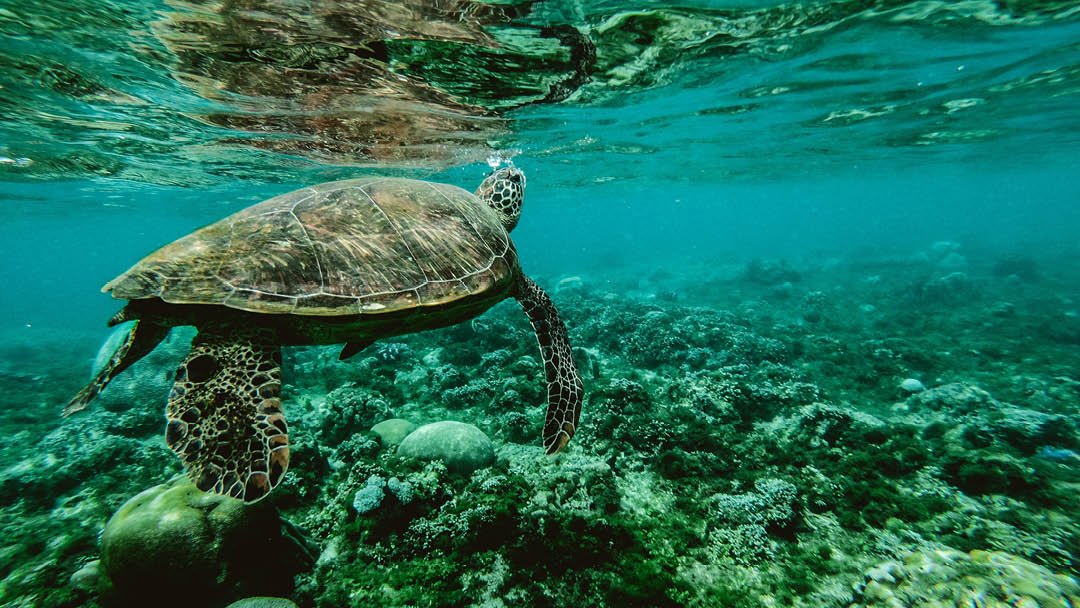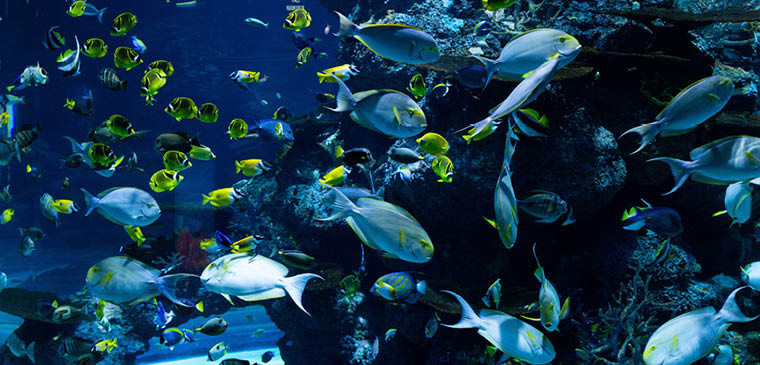Use of antifouling methods to prevent the build up of marine fouling on the hulls of boats has multiple benefits to boat owners, including improving fuel efficiency and performance. Hulls may gather up to 150kg of fouling per square metre in just six months, with a suggested fuel consumption increase of 50% without the use of any fouling control.
However, as people become more aware of the implications of their actions on the environment, we wanted to shed some light on the impact of antifouling paint and the alternatives on marine ecosystems, as well as why we should all care.
Marine biodiversity – what is it and why is it important?
Biodiversity is all the different types of life you find in one environment; from the microorganisms to the predators and everything in between, including the plants. Ecosystems are relatively fragile and carefully balanced systems in which all the different organisms living in an area all rely on each other and how they interact with the physical world around them. Targeting certain marine organisms with chemicals, such as those used in traditional antifouling or introducing new creatures to it can be catastrophic to the health of our oceans.
Our oceans are key to the health of our planet, with the providing more than 50% of the oxygen we breathe and storing 50 times more carbon than the Earth’s atmosphere. However, the WWF report that around 66% of the ocean environment of our planet has been altered in recent decades. Reducing your use of chemicals and making sure you know the impact of your choices on the environment is even more important now than it has ever been.
Importance of antifouling to prevent transfer of invasive non-native species
Our previous blog may have spoken about the benefits of a biofoul-free hull on boat performance and fuel consumption, great for reducing carbon dioxide and other greenhouse gas emissions. However, one thing we haven’t spoken much about is the beneficial effect of antifouling on the transport of potentially invasive, non-native species that can attach to the boat hulls that can impact the ecosystems they are deposited in.
Transport of invasive species from one area of the world to another is well documented. One example in the introduction of tube worms (Ficopomatus enigmaticus) to UK waters from Australia from the hulls of boats. They can form reef like structures 4m wide and 2m high, making them a huge fouling nuisance for both ships and harbours.
Another example is zebra mussels which were introduced to the USA from Europe, these mussels remove algae that other marine organisms depends upon to survive as well as physically attaching to and incapacitating native mussels. This upsets the delicate balance within the ecosystems of the great lakes of America, having negative impacts on many of the species within the water.
How to prevent the transfer of invasive species
Cleaning the underside of your boat thoroughly before and after long trips will ensure you minimise the potential transfer of invasive species between different marine ecosystems. This will help to preserve biodiversity and ensure healthy and robust ecosystems can be maintained.
Another way of preventing fouling transfer is to use antifouling. Traditionally this is a paint applied as several gel coats which contains chemical pesticides, such as copper oxide, to kill off any marine life that does attach.
Ultrasonic antifouling technologies help protect the areas that are tricky to reach with conventional paints such as propellers, inlet grill and cooling systems. Invasive species can end up hidden in these areas, therefore ultrasonic antifoul technology is a fantastic way to minimise the likelihood of you transferring invasive species on a vessel.
How traditional antifouling paints work compared to ultrasonic antifouling
As we have mentioned previously, traditional antifouling paints work by containing organic biocides – otherwise known as pesticides. Although, after extensive research, previous formulations of antifoul which include the extremely toxic tributyltin (TBT) have now been banned in many countries on leisure boats and those under 25m. However, the ‘safer’ formulations of other biocide-containing paints does not mean they do not cause harm or pollution.
These newer formulations are predominantly copper oxide-based and work to kill and therefore prevent the attachment of algae and other marine fouling, in turn preventing larger organisms such as barnacles and mussels would usually feed on the algae and other biofoul from attaching. In order for these paints to meet strict standards and contain lower copper concentrations or less powerful ingredients like cuprous thiocyanate, they often require additional biocides which can be zinc based, elevated levels of which can also have harmful effects on the aquatic environment.
Ultrasonic antifouling systems use transducers attached to the outer hull that emit ultrasonic (very high frequency) sound waves. These ultrasonic waves create microcurrents which prevent the attachment of aquatic life to the hull of the vessel. These ultrasonic waves do not harm aquatic life, do not interfere with marine mammals which use sonar navigation or cause any damage to the environment, providing multiple environmental benefits.
Why traditional antifouling paints are bad for the marine environment
Release of paint particles into the marine environment
‘Soft’ or ‘ablative’ antifouling coatings work by shedding the outermost coat of paint as the boat moves through the water, taking with it any microorganisms that are attached and always leaving a fresh coating of biocide exposed. Alternatively, ‘hard’ antifouling paints contain the copper particles suspended in an epoxy resin coating that slowly leeches the copper when in contact with sea water. The copper then reacts with oxygen dissolved in the water to create cupric ions which work to repel weed and mollusc growth, although additional biocides are often needed to prevent the attachment of other organic matter.
Use of ultrasonic antifouling technologies greatly reduces the amount of antifouling paint required. They therefore show great environmental benefits compared to traditional methods which can lead to elevated levels of paint particles, copper and other heavy metals in the sea.
Impact on the local aquatic ecosystem
With painted surfaces polluting the oceans and killing or incapacitating the algae and smaller organisms which other marine life needs to feed on biocides often accumulate in the food chain. This means that even the food we eat has been contaminated with copper and other biocides, copper containing biocides have been shown to be harmful to human health, particularly at such elevated concentrations. Copper is one of the most poisonous heavy metals when present in excess, with the estimates of the amount of copper used annually on coastal leisure boats to be between 75,173 and 311,769 Kg. Further research is needed into the effects of copper concentrations on the local marine environment and aquaculture but it is known to cause toxicity by impairing water and ion regulation in the gills of multiple aquatic animals as well as by generating reactive oxygen species (free radicals).
Several countries are now considering a ban on copper-based antifouls and to underwater hull cleaning which can also contribute to release of toxic copper particulate matter within harbours suggesting an increasing need to switch to copper-free alternatives.
However, pollution of booster biocides added to paints alongside copper have been shown to have off-target effects for other species, with several shown to be growth inhibitors of marine plants, influencing the growth of both sea grasses and corals. This again increases demand for biocide free alternatives such as ultrasonic antifouling.
Contribution to antibiotic resistance
Recently use of high concentrations of biocides has been shown to exert selective stress on bacteria. This can lead to mutations within the bacteria that can make them resistant not just to the biocides but also to some antibiotics.
Incorrect disposal and spillage of antifouling paint
It’s not just boats in the water that can lead to pollution with antifouling paint particles. Sanding down the old coatings during annual cleaning, maintenance and antifoul renewal creates a mass of paint dust particles that the boat owner requires full personal protective equipment (PPE) protection from, yet they are often released into the environment with little thought. These particles can go on to have a detrimental effect on aquatic organisms and their marine environments, particularly in the coastal waters.
Recently, tighter regulations have come into force from the British Coatings Federation with their DIY antifouling initiative which suggests that old paint be wet sanded to reduce dust, a vacuum cleaner attachment is used on any scraper when removing old paint and a tarpaulin is used to collect any additional dust or paint spillage during the procedure. Furthermore, any excess paint must be treated as hazardous waste and disposed of correctly through local chemical waste disposal.
This is another area where ultrasonic antifouling systems come into their own with yet another environmental benefit. By reducing the frequency by which antifoul paint needs to be reapplied to a vessel from annually to every three to five years, they help significantly reduce the amounts of toxic paint particles being released into the environment.
The future of antifouling- ultrasonic technologies?
Biocide free paints have been developed but have been shown to still leech toxic chemicals such as bisphenol A into the environment.
Ultrasonic technologies are completely chemical free and greatly reduce the need for use of traditional fouling control. By using high frequency waves to deter the attachment of marine life to the hull, without affecting non-target species, it is a safe and environmentally friendly alternative for use on vessels of all different sizes. Furthermore, the ultrasonic waves protect more of the boat surface that traditional paint, including all those tricky to reach inlet pipes, giving a better coverage.
Have you been persuaded to try ultrasonic antifouling technology? If so you can learn more about our products here or contact our team to discuss your needs and find the perfect product for you and your boat.


